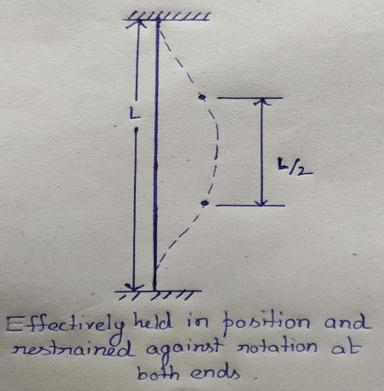This set of Design of RC Structures Multiple Choice Questions & Answers (MCQs) focuses on “Axially Loaded Columns”.
1. Which of the following is the function of the transverse reinforcement in a column?
a) To prevent longitudinal buckling of longitudinal reinforcement
b) To prevent certain brittle failure
c) To impart certain ductility to the column
d) To reduce effect of creep
View Answer
Explanation: The function of the transverse reinforcement is to prevent buckling of the longitudinal reinforcement. The function of the longitudinal reinforcement are:
i) To prevent certain brittle failure
ii) To impart certain ductility to the column
iii) To reduce effect of creep.
2. A braced column is not subjected to which of the following?
a) Axial load
b) Compressive load
c) Deflection
d) Side sway
View Answer
Explanation: If lateral support is given to one or both directions of a column, the column is called the braced column. Bracings totally bear the lateral loads like wind load etc. Therefore, the side sway is not allowed in this column. The column is not subjected to lateral movement
3. The load carrying capacity (P) of an axially loaded short column provided with lateral tie is given by________________
a) ϬccAc+ϬscAc
b) ϬscAc+ϬccAsc
c) ϬccAc+ϬscAsc
d) ϬscAc+ϬccAsc
View Answer
Explanation: According to recommendation of IS 456:2000 the load carrying capacity is given by-
P = ϬccAc+ 1.5mϬccAsc
now, 1.5m Ϭcc = Ϭsc
P = ϬccAc+ ϬscAsc
where Ϭcc = Permissible compressive stress in concrete; Ac=Area of concrete
Ϭsc = Permissible compressive stress in column bar; Asc=Area of steel reinforcement.
4. The range of the longitudinal reinforcement for a column should be ____________________
a) between .8 percent to 6 percent of the gross cross sectional area of the column
b) between .4 percent to 8 percent of the gross cross sectional area of the column
c) between .2 percent to 6 percent of the gross cross sectional area of the column
d) between .8 percent to 10 percent of the gross cross sectional area of the column
View Answer
Explanation: IS 456:2000 gives the range of longitudinal reinforcement for a column as .8 to 6 percent of the gross cross sectional area. The use of 6 percent may involve in placing difficulties; therefore lower percentage is prescribed by the experts.
5. A column having longitudinal reinforcement tied with spirals (helical reinforcement), has greater load carrying capacity than the similar members with lateral ties.
a) False
b) True
View Answer
Explanation: For a column having helical reinforcement the load carrying capacity is taken 1.05 times of the similar members with the lateral ties as mentioned in the IS standard code. This recommendation is widely used for short columns.
6. What is the unsupported length of a column in a flat slab?
a) Clear distance between the floor and the lower extremity
b) Clear distance between floor and the underside of the shallower beam framing into the floor
c) Clear distance between consecutive struts in each vertical plane
d) Clear distance between two columns
View Answer
Explanation: The unsupported length of a column in the flat slab is clear distance between the floor and the lower extremity. Where as in a beam slab of two consecutive floor construction the effective length is taken as the clear distance between floor and the underside of the shallower beam framing into the floor. The effective length between two columns or struts is taken as clear distance between struts and columns in vertical plane respectively.
7. A column is 5m long (effective) and 500mm in diameter. What kind of column is this?
a) long
b) Slender
c) Short
d) Thick
View Answer
Explanation: According to codal provision,
lef/D<12 for a column to be short.
Here l=5000mm and b=D=500mm ; l/b=10 < 12
Hence the column is a short one.
8. For a column of 10m effective length and 500mm column diameter, what is the reduction factor?
a) .43
b) .83
c) .73
d) .63
View Answer
Explanation: Reduction Factor Cr=1.25-(lef/48b)
=1.25-(10000/48*500)=.8333.
9. The diameter of the lateral ties shall not be more than 4mm.
a) True
b) False
Explanation: The diameter of the lateral tie must satisfy the following criteria
i. It must not be less than 5mm.
ii. It should not be less than one fourth of the diameter of the largest longitudinal bar given as reinforcement of the section.
10. What is the theoretical value of effective length for a compression member which is effectively held in position and restrained against rotation in both ends?
a) .6l
b) .8l
c) .5l
d) .7l
View Answer
Explanation: Effective length is the length between two points where the bending moment changes its sign i.e. positive bending moment becomes negative and vice versa. From the figure it is clear that the bending moment changes its sign at two particular points and the distance between them is .5l.

Sanfoundry Global Education & Learning Series – Design of RC Structures
To practice all areas of Design of RC Structures, here is complete set of 1000+ Multiple Choice Questions and Answers.
If you find a mistake in question / option / answer, kindly take a screenshot and email to [email protected]
